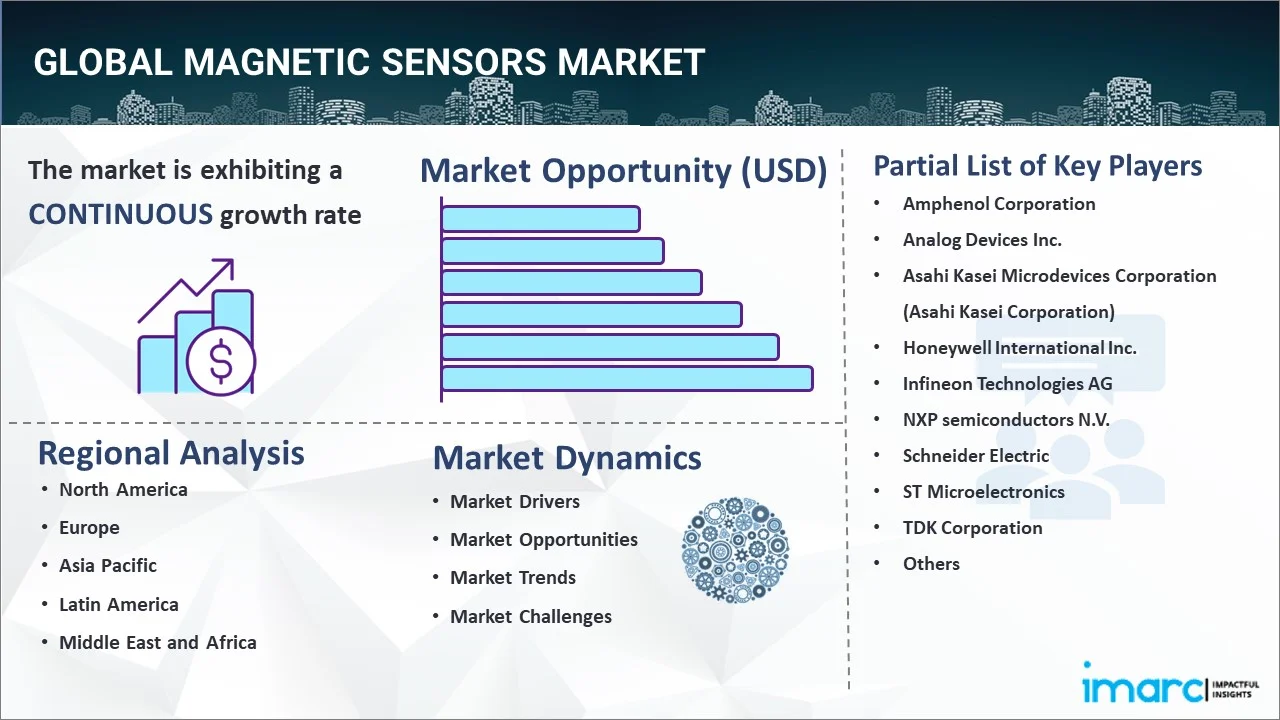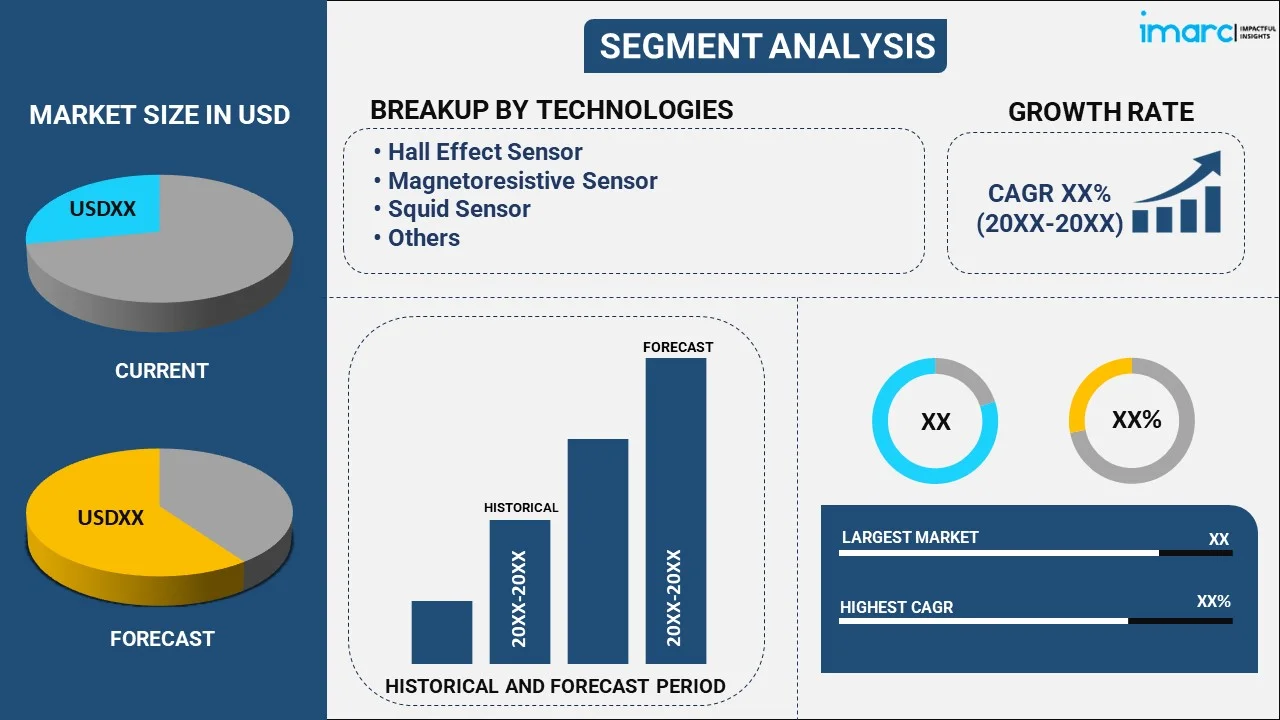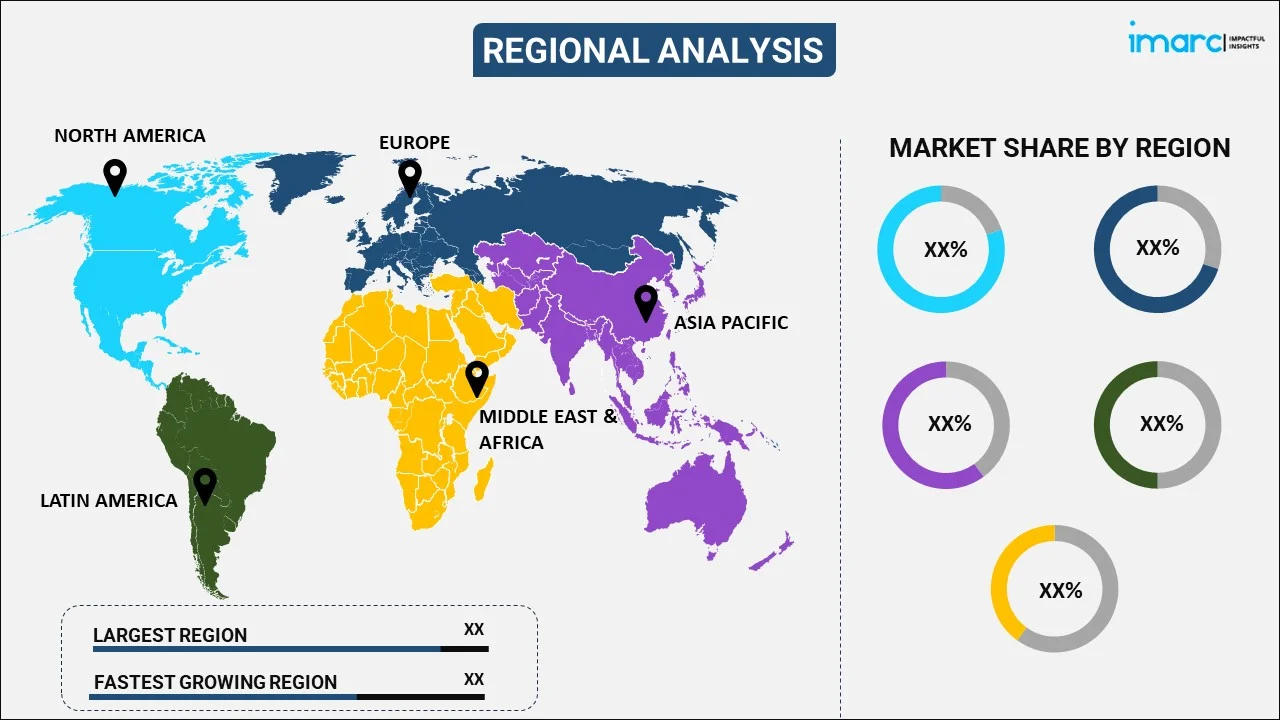
Magnetic Sensors Market Report by Technology (Hall Effect Sensor, Magnetoresistive Sensor, Squid Sensor, Fluxgate Sensor, and Others), Application (Speed Sensing, Detection, Position Sensing, Navigation, and Others), End Use (Aerospace and Defense, Automotive, Consumer Electronics, Healthcare, and Others), and Region 2025-2033
Global Magnetic Sensors Market:
The global magnetic sensors market size reached USD 4.5 Billion in 2024. Looking forward, IMARC Group expects the market to reach USD 8.2 Billion by 2033, exhibiting a growth rate (CAGR) of 6.13% during 2025-2033. The growing demand for automotive safety features is stimulating the market.
|
Report Attribute
|
Key Statistics
|
|---|---|
|
Base Year
|
2024
|
|
Forecast Years
|
2025-2033
|
|
Historical Years
|
2019-2024
|
| Market Size in 2024 | USD 4.5 Billion |
| Market Forecast in 2033 | USD 8.2 Billion |
| Market Growth Rate (2025-2033) | 6.13% |
Magnetic Sensors Market Analysis:
- Major Market Drivers: The increasing focus on industrial automation is driving the use of magnetic sensors to improve accuracy and efficiency in manufacturing processes.
- Key Market Trends: The rising production of consumer electronics is leading to higher adoption of magnetic sensors, which is acting as a significant growth-inducing factor.
- Competitive Landscape: Some of the major market companies include Amphenol Corporation, Analog Devices Inc., Asahi Kasei Microdevices Corporation (Asahi Kasei Corporation), Honeywell International Inc., Infineon Technologies AG, NXP semiconductors N.V., Schneider Electric, ST Microelectronics, TDK Corporation, TE Connectivity, and Texas Instruments Incorporated, among many others.
- Geographical Trends: In Asia Pacific, rapid industrialization and automotive demand drive growth. Moreover, Europe focuses on automotive innovation and renewable energy, and North America sees strong demand from consumer electronics and healthcare. In addition, Latin America has emerging industrial applications, while Middle East and Africa focus on oil, gas, and infrastructure projects.
- Challenges and Opportunities: The sensitivity to external magnetic interference is hindering the market. However, developing more advanced shielding techniques and integrating signal processing algorithms to improve accuracy in challenging environments will continue to strengthen the magnetic sensors market demand over the forecast period.

Magnetic Sensors Market Trends:
Growing Demand for High-Precision Sensors
Magnetic sensors are increasingly required for applications that demand high accuracy in position, motion, and angle detection. In contrast, industries such as automotive, industrial automation, and consumer electronics rely on these sensors to provide precise measurements, thereby improving overall performance and efficiency in complex operational environments. For instance, in January 2024, Infineon Technologies launched the XENSIV TLI5590-A6W, a high-precision TMR magnetic position sensor. It is ideal for industrial and consumer applications, especially in harsh environments with temperatures up to +125°C, featuring ultra-high sensitivity, low power consumption, and accuracy better than 10 µm.
Increasing Use in Safety Applications
The adoption of magnetic sensors in safety-critical applications is rising due to their ability to provide reliable and redundant measurements. Moreover, these sensors are used in environments where accurate position detection is vital, such as in automotive safety systems and industrial machinery, thereby ensuring enhanced operational safety and system reliability. For instance, in June 2024, TDK launched the TAS8240, a compact, redundant TMR angle sensor designed for automotive and industrial safety-critical applications. Also, it enhances rotor position measurement in power steering and traction motors, offering a high accuracy of ±1.0° and stability across temperature and magnetic-field ranges.
Rising Focus on Energy-Efficient Solutions
Magnetic sensors are being designed with ultra-low power requirements with the need for longer battery life and reduced power consumption in devices. Furthermore, this makes them ideal for battery-powered applications across various sectors, thereby enabling efficient energy management without compromising the performance of sensors in detecting and processing magnetic field data. For instance, in June 2024, MultiDimension Technology (MDT) introduced the AMR132x and AMR134x magnetic switch sensor series. These sensors offer 360° magnetic field detection, ultra-low power consumption, and high-speed operation, enhancing applications like magnetic tamper detection in utility meters and pneumatic cylinder position sensing.
Global Magnetic Sensors Industry Segmentation:
IMARC Group provides an analysis of the key trends in each segment of the market, along with the magnetic sensors market forecast at the global, regional, and country levels for 2025-2033. Our report has categorized the market based on technology, application, and end use.
Breakup by Technology:

- Hall Effect Sensor
- Magnetoresistive Sensor
- Squid Sensor
- Fluxgate Sensor
- Others
The report has provided a detailed breakup and analysis of the market based on the technology. This includes hall effect sensor, magnetoresistive sensor, squid sensor, fluxgate sensor, and others.
Magnetic sensor technology includes hall effect sensor for position sensing, magnetoresistive sensor for weak magnetic fields. In contrast, SQUID sensor for precision in scientific applications, and fluxgate sensor for detecting Earth’s magnetic fields. Meanwhile, others technology also enhances performance in various industrial and automotive applications.
Breakup by Application:
- Speed Sensing
- Detection
- Position Sensing
- Navigation
- Others
The report has provided a detailed breakup and analysis of the market based on the application. This includes speed sensing, detection, position sensing, navigation, and others.
Magnetic sensors are widely used in applications like speed sensing, detection, and position sensing. On the contrary, they accurately measure the rotational speed of shafts in automotive and industrial machinery. Furthermore, navigation systems detect magnetic fields for orientation, while others use include proximity detection and flow measurement in various industries.
Breakup by End Use:
- Aerospace and Defense
- Automotive
- Consumer Electronics
- Healthcare
- Others
The report has provided a detailed breakup and analysis of the market based on the end use. This includes aerospace and defense, automotive, consumer electronics, healthcare, and others.
In aerospace and defense magnetic sensors enhance navigation systems and vehicle control and in automotive, they are critical for detecting position and speed. In contrast, consumer electronics rely on them for motion sensing in devices and healthcare utilizes magnetic sensors for imaging and diagnostics, while others industry use them in automation and industrial machinery.
Breakup by Region:

- North America
- United States
- Canada
- Asia-Pacific
- China
- Japan
- India
- South Korea
- Australia
- Indonesia
- Others
- Europe
- Germany
- France
- United Kingdom
- Italy
- Spain
- Russia
- Others
- Latin America
- Brazil
- Mexico
- Others
- Middle East and Africa
The market research report has also provided a comprehensive analysis of all the major regional markets, which include North America (the United States and Canada); Asia Pacific (China, Japan, India, South Korea, Australia, Indonesia, and others); Europe (Germany, France, the United Kingdom, Italy, Spain, Russia, and others); Latin America (Brazil, Mexico, and others); and the Middle East and Africa.
As per the market overview, Asia Pacific is driven by strong demand for automotive and consumer electronics. In contrast, Europe and North America focus on industrial automation and healthcare applications. Moreover, Latin America sees steady growth with increasing investments in infrastructure and energy sectors. Meanwhile, the Middle East and Africa are gradually adopting magnetic sensors in oil, gas, and renewable energy projects, contributing to market expansion.
Competitive Landscape:
The magnetic sensors market research report has provided a comprehensive analysis of the competitive landscape. Detailed profiles of all market companies have also been provided. Some of the key players in the market include:
- Amphenol Corporation
- Analog Devices Inc.
- Asahi Kasei Microdevices Corporation (Asahi Kasei Corporation)
- Honeywell International Inc.
- Infineon Technologies AG
- NXP semiconductors N.V.
- Schneider Electric
- ST Microelectronics
- TDK Corporation
- TE Connectivity
- Texas Instruments Incorporated
(Please note that this is only a partial list of the key players, and the complete list is provided in the report.)
Magnetic Sensors Market Recent Developments:
- June 2024: MultiDimension Technology (MDT) introduced the AMR132x and AMR134x magnetic switch sensor series. These sensors offer 360° magnetic field detection, ultra-low power consumption, and high-speed operation, enhancing applications like magnetic tamper detection in utility meters and pneumatic cylinder position sensing.
- June 2024: TDK launched the TAS8240, a compact, redundant TMR angle sensor designed for automotive and industrial safety-critical applications. Also, it enhances rotor position measurement in power steering and traction motors.
- January 2024: Infineon Technologies launched the XENSIV TLI5590-A6W, a high-precision TMR magnetic position sensor. It is ideal for industrial and consumer applications, especially in harsh environments with temperatures up to +125°C, featuring ultra-high sensitivity, low power consumption, and accuracy better than 10 µm.
Magnetic Sensors Market Report Scope:
| Report Features | Details |
|---|---|
| Base Year of the Analysis | 2024 |
| Historical Period | 2019-2024 |
| Forecast Period | 2025-2033 |
| Units | Billion USD |
| Scope of the Report | Exploration of Historical Trends and Market Outlook, Industry Catalysts and Challenges, Segment-Wise Historical and Future Market Assessment:
|
| Technologies Covered | Hall Effect Sensor, Magnetoresistive Sensor, Squid Sensor, Fluxgate Sensor, Others |
| Applications Covered | Speed Sensing, Detection, Position Sensing, Navigation, Others |
| End Uses Covered | Aerospace and Defense, Automotive, Consumer Electronics, Healthcare, Others |
| Regions Covered | Asia Pacific, Europe, North America, Latin America, Middle East and Africa |
| Countries Covered | United States, Canada, Germany, France, United Kingdom, Italy, Spain, Russia, China, Japan, India, South Korea, Australia, Indonesia, Brazil, Mexico |
| Companies Covered | Amphenol Corporation, Analog Devices Inc., Asahi Kasei Microdevices Corporation (Asahi Kasei Corporation), Honeywell International Inc., Infineon Technologies AG, NXP semiconductors N.V., Schneider Electric, ST Microelectronics, TDK Corporation, TE Connectivity, Texas Instruments Incorporated, etc. |
| Customization Scope | 10% Free Customization |
| Post-Sale Analyst Support | 10-12 Weeks |
| Delivery Format | PDF and Excel through Email (We can also provide the editable version of the report in PPT/Word format on special request) |
Key Questions Answered in This Report
- How has the global magnetic sensors market performed so far and how will it perform in the coming years?
- What has been the impact of COVID-19 on the global magnetic sensors market?
- What are the key regional markets?
- What is the breakup of the market based on the technology?
- What is the breakup of the market based on the application?
- What is the breakup of the market based on the end use?
- What are the various stages in the value chain of the industry?
- What are the key driving factors and challenges in the industry?
- What is the structure of the global magnetic sensors market and who are the key players?
- What is the degree of competition in the industry?
Key Benefits for Stakeholders:
- IMARC's industry report offers a comprehensive quantitative analysis of various market segments, historical and current market trends, market forecasts, and dynamics of the magnetic sensors market from 2019-2033.
- The research report provides the latest information on the market drivers, challenges, and opportunities in the global magnetic sensors market.
- The study maps the leading, as well as the fastest-growing, regional markets. It further enables stakeholders to identify the key country-level markets within each region.
- Porter's five forces analysis assists stakeholders in assessing the impact of new entrants, competitive rivalry, supplier power, buyer power, and the threat of substitution. It helps stakeholders to analyze the level of competition within the magnetic sensors industry and its attractiveness.
- The competitive landscape allows stakeholders to understand their competitive environment and provides insight into the current positions of key players in the market.
Need more help?
- Speak to our experienced analysts for insights on the current market scenarios.
- Include additional segments and countries to customize the report as per your requirement.
- Gain an unparalleled competitive advantage in your domain by understanding how to utilize the report and positively impacting your operations and revenue.
- For further assistance, please connect with our analysts.
 Inquire Before Buying
Inquire Before Buying
 Speak to an Analyst
Speak to an Analyst
 Request Brochure
Request Brochure
 Request Customization
Request Customization




.webp)




.webp)












